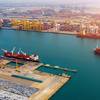ITC: Houston Petrochemical Blaze Extinguished
Firefighters on Wednesday extinguished a fire at a Mitsui & Co petrochemical storage site outside Houston that has been billowing acrid smoke for days, the company said.
The blaze at Mitsui unit Intercontinental Terminals Co in Deer Park, Texas, was put out by 3 a.m., but fire crews continued to spray foam and water on the tanks to help keep them cool and prevent the fires from starting again, the company said in a statement.
No serious injuries were reported, it said. Fire officials were not immediately available for comment.
The fire began on Sunday when a leaking tank containing volatile naphtha, a fuel used in the production of gasoline, ignited and flames quickly spread to other tanks, ITC said. By Tuesday morning, the fire had ignited 12 of 15 tanks.
The tanks each hold up to 80,000 barrels, or 3.3 million gallons, of volatile liquid fuels, making the fire difficult to extinguish. There were no employees or firefighters injured since the blaze began, an ITC spokesman said on Tuesday.
State and federal monitors said air quality was safe, but environmental groups disagreed and said they would conduct their own monitoring.
The Texas Commission on Environmental Quality reported an increase in soot and other contaminants at ground levels around the site but said levels remained below those considered unhealthy. Monitoring by an Environmental Protection Agency aircraft also found "no significant detections," the EPA said.
"All the monitors are indicating no risk right now and they are looking at particulates," said Ryan Sitton, a commissioner with the state's energy regulator, adding there were no toxins released by the fire. Soot particles "are not at a level that causes risk to people," he said.
But Neil Carmen, a director at the Texas chapter of the Sierra Club environmental group, said the airborne plume likely contained tens of thousands of milligrams of particles, well above levels considered safe.
The Environmental Defense Fund (EDF), a nongovernmental organization, was deploying 10 air-quality monitors to check for nitrogen oxides and soot around Houston and adding another 10 monitors in the near future, said Matt Tresaugue, an EDF spokesman. He said the city had requested the EDF monitors.
As the company had struggled to contain the blaze earlier this week, it has changed its explanation for the fire's spread and the number of tanks involved.
On Monday, it said eight tanks were burning then revised the figure to seven. On Tuesday morning it blamed a failure of two water pumps for the fire's expansion to more tanks, and by the afternoon said there were no pump failures.
Gasoline prices on the Colonial pipeline, which sends fuel to the U.S. East Coast from Houston, were up on Tuesday between 1 and 2 cents a gallon over levels prior to the fire.
Some of the water and chemicals have washed into the adjacent Houston Ship Channel that links the Gulf of Mexico to Houston, the nation's busiest petrochemical port, ITC spokesman Dale Samuelsen said.
(Reporting by Erwin Seba and Gary McWilliams












